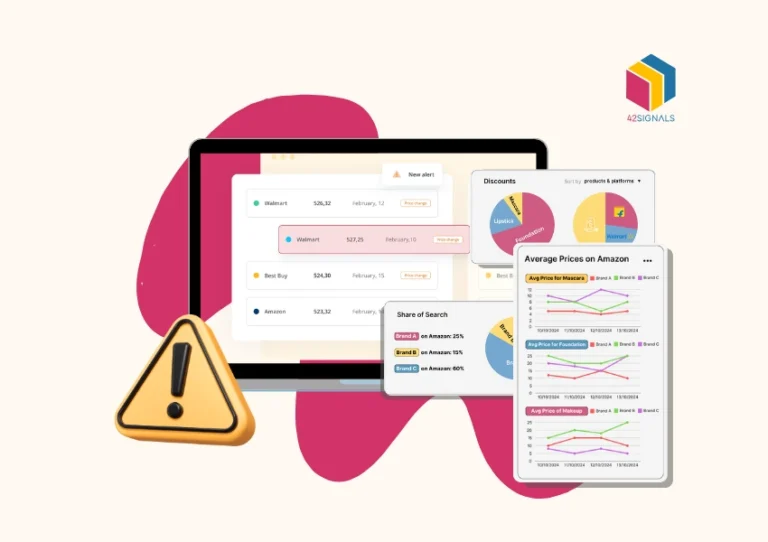Table of Contents
ToggleIn 2025, manual competitor tracking will be as dead as fax machines. The brands winning today aren’t just watching rivals—they’re using AI-powered competitor tracking tools, price alerts, and competitor analysis dashboards to predict moves before they happen. Let’s understand how to competitor monitor brands.
Imagine knowing your competitor will slash prices next Tuesday… on Friday. Or spotting a rival’s inventory glut and hijacking their traffic with a flash sale. It can easily happen with a cutting-edge competitor monitoring tool.
Here’s your step-by-step plan.
How to Competitor Monitor
Step 1: Deploy AI-powered Competitor Monitoring Tools
Forget Google Alerts. 2025’s tools are like having a spy network on steroids.
The ECommerce Analytics Tool to Use for Competitor Monitor
While platforms like Google Analytics 360 or Adobe Analytics provide crucial internal performance data, the modern e-commerce battleground demands a weapon capable of external reconnaissance and predictive intelligence. Enter 42Signals – an advanced competitive intelligence (CI) platform leveraging AI-powered web scraping to transform mountains of external data into actionable strategic insights. This isn’t just reporting; it’s about gaining a decisive, real-time advantage.
Why Traditional Analytics Aren’t Enough:
Most analytics tools excel at telling you what happened on your own site: traffic sources, conversion rates, bounce rates, and popular products. This is vital, but it’s inherently reactive and introspective. They offer limited visibility into:
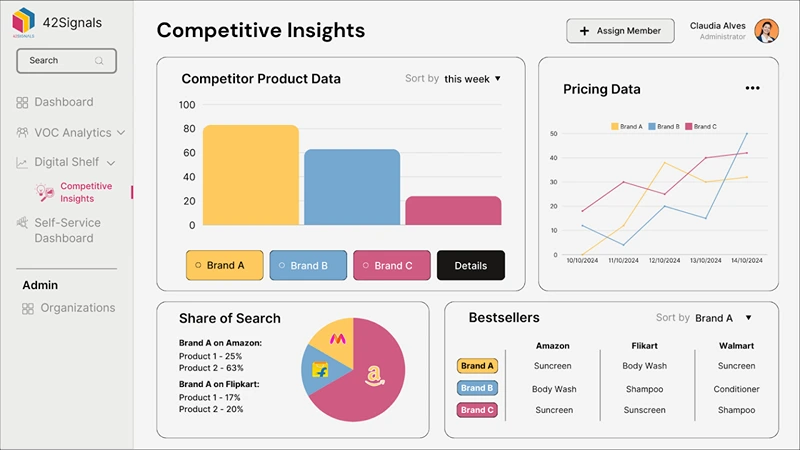
- 42Signals: Uses web scraping and AI to scrape competitor websites, ecommerce marketplaces, and even quick commerce applications to detect price changes, customer sentiment, and product information data. Some of the advanced features of the platform include –
- Quick commerce platform tracking – the ability to track products and competitors’ activities on quick commerce applications to improve sales and operations.
- Understand competitor trends, pricing strategies, and bestselling products to make prompt decisions.
- Learn about the share of search on online marketplaces and make product and keyword changes quickly.
42Signals: The External Intelligence Engine to Competitor Monitor
42Signals addresses these blind spots by continuously scraping and analyzing data from a vast array of public sources:
- Competitor Websites: Product catalogs, pricing, descriptions, stock status, promotions, and new arrivals.
- Major E-commerce Marketplaces: Amazon, Walmart.com, eBay, Target.com, and regional giants. Tracking rankings, SOS, reviews, pricing, buy box ownership.
- Quick Commerce (Q-Commerce) Apps: Monitoring product availability, pricing, promotions, and delivery promises on platforms like Instacart, DoorDash (for retail), GoPuff, Getir, etc.
- Review Sites & Social Media: Aggregating sentiment analysis from platforms relevant to your products.
- Public Logistics/Shipment Data (Advanced Use Cases): As seen in the Nike case study.
Advanced Features Driving Optimization:
- Real-Time Price & Promotion Tracking:
- Dynamic Pricing Fuel: See competitor price drops instantly. Feed this data into your own dynamic pricing engine to stay competitive without manual checks or guesswork. Identify pricing patterns and thresholds.
- Promotional Strategy Insights: Understand the frequency, depth, and type of promotions competitors run (BOGO, % off, bundles). Time your promotions strategically to counter or capitalize on market activity.
- MAP (Minimum Advertised Price) Monitoring: Ensure resellers or competitors aren’t violating pricing agreements.
- Quick Commerce (Q-Commerce) Platform Tracking:
- Hyper-Local Competitive Landscape: Understand which competitors are winning on instant delivery apps in specific geographies. Track their product assortment, pricing premiums (or discounts) for speed, and promotional tactics within these high-velocity channels.
- Inventory Pulse for Speed: Monitor stock-outs or surging popularity of items on Q-commerce to adjust your own inventory allocation or fulfillment strategies for these platforms.
- Channel Strategy Validation: Quantify the true reach and competitive intensity of Q-commerce for your category, informing investment decisions in this rapidly growing space.
- Competitor Benchmarking & Trend Detection:
- Bestseller Analysis: Identify not just what competitors are selling, but how much and how fast. Uncover their true top performers across categories.
- New Product Launches & Assortment Shifts: Get early warnings about competitor innovations, category expansions, or discontinuations. React faster than traditional market research allows.
- Marketing & Messaging Analysis: Track changes in competitor product descriptions, imagery, key selling points, and category structures to understand their evolving positioning and messaging strategies.
- Share of Search (SOS) Intelligence:
- Keyword Dominance Gauge: See which competitor ranks highest for the most critical product keywords on marketplaces. SOS is a powerful leading indicator of market share and visibility.
- Opportunity Identification: Discover high-volume keywords where your competitors are weak, allowing you to optimize listings and advertising to capture that traffic.
- Trend Spotting: Identify rising search terms before they become mainstream, enabling proactive product development or content creation.
- Listing Optimization Validation: Test how changes to your product titles, bullet points, and backend keywords impact your SOS relative to competitors.
- Customer Sentiment Analysis (Beyond Your Brand):
- Competitor Weakness Radar: Analyze reviews and discussions about competitor products to identify recurring complaints, quality issues, or feature gaps. Highlight these weaknesses in your marketing or address them with your product development.
- Unmet Need Discovery: Find common desires or frustrations expressed by customers about the entire category, not just your brand, informing innovation.
- Feature Prioritization: Understand which features or benefits customers truly value (or despise) in competitor offerings.
Case Study – The Sneaker Startup That Out-Niked Nike
The Challenge: A direct-to-consumer (DTC) sneaker startup competed in a market dominated by Nike, especially on Amazon. They lacked Nike’s massive marketing budget and brand recognition.
The 42Signals Edge: The platform wasn’t just scraping Nike’s product pages. It utilized sophisticated data collection, potentially including:
Supplier Portals/Logistics Feeds: Monitoring shipping manifests or port data (publicly available or through specialized data vendors) associated with Nike’s known suppliers or logistics partners.
Freight Forwarder Data: Tracking shipment delays or cancellations impacting Nike’s supply chain routes.
Factory Region News/Social Media: Detecting local disruptions (COVID, strikes, weather) affecting key manufacturing hubs.
The Insight: 42Signals algorithms detected significant delays in key Nike shipments destined for Amazon fulfillment centers, predicting a major stock-out of popular models during the crucial peak season (Back-to-School or Holidays).
The Action: The startup CEO didn’t hesitate:
Aggressive Inventory Buildup: Leveraged their agile supply chain to rapidly increase production and stockpile their competing models.
Targeted Campaign: Launched a bold “Never Out of Stock” guarantee campaign on Amazon, directly contrasting with Nike’s impending shortage. Campaign creatives subtly emphasized reliability and immediate availability.
Keyword & Listing Blitz: Used 42Signals SOS data to identify the exact high-traffic keywords Nike was dominating but would soon struggle to fulfill. Optimized their Amazon listings (titles, bullets, backend keywords) aggressively for these terms. Implemented strategic, slight price undercutting.
The Result: As predicted, Nike stock dwindled. Shoppers searching for those popular sneakers found Nike listings unavailable or with long delivery estimates. The startup’s optimized listings, prominent availability guarantee, and competitive pricing captured the displaced demand:
Stole 12% of Nike’s Amazon Traffic: A massive shift in visibility during the most critical sales period.
Significant Revenue Surge: Capitalized on peak-season buyer intent that would have otherwise gone unfulfilled.
Brand Credibility Boost: The “Never Out of Stock” promise resonated, building trust and repeat customers.
Pro Tip to Competitor Monitor
The provided “Pro Tip” is a game-changer for agile e-commerce operations:
Human Oversight: While automation is powerful, set thresholds and review logs. Not every competitor move warrants an identical response. The goal is speed and relevance, not mindless copying.
Identify Alpha Competitors: In your 42Signals dashboard, designate 2-3 key competitors whose strategies are most relevant or threatening.
Define Trigger Keywords: Identify high-value, non-branded keywords crucial to your category (e.g., “best gifts for teens,” “wireless noise cancelling headphones,” “organic cotton sheets”). Track these relentlessly.
Set Up Automated Alerts & Actions:
Alert: The moment 42Signals detects a designated competitor (e.g., “Rival X”) significantly improving their ranking or winning the buy box for a trigger keyword.
Automatic Analysis: The platform can analyze Rival X’s listing for that keyword at the time of ranking improvement – price, key phrases in title/bullets, promotion, image changes.
Automated Response (Proposed Action):
Keyword Optimization: Auto-trigger a script or notification to your SEO/content team to immediately optimize your own relevant listings for that same keyword, mirroring successful elements found in Rival X’s listing (e.g., incorporating specific phrases).
Dynamic Repricing: Feed Rival X’s price into your repricing engine with a rule: “If Rival X ranks #1 for Keyword Y, set my price for Product Z to 10% below theirs.” (Ensure this aligns with profitability goals!).
Promotion Match/Beat: Trigger an automated promotion (e.g., a coupon) if Rival X is running one.
Step 2: Weaponize Real-Time Price Alerts
Price alerts in 2025 aren’t just notifications—they’re automated counterstrikes.
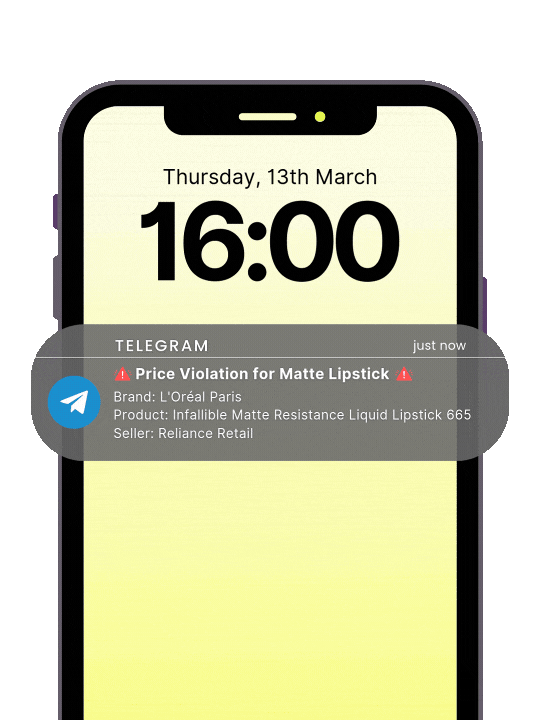
How to Set It Up
Choose Your Triggers
- MAP Violations: Get alerts when rivals dip below Minimum Advertised Price. Auto-report them to sellers to nip any violations that can devaluate your brand in the bud.
- Flash Sales: Tools like PriceYak 2.0 can trigger instant discounts on your end when competitors launch 24-hour deals. This means you stay competitive at all times and do not lose out of sales because of competitor discounts.
- Stock-Outs: When a rival’s inventory hits 10%, auto-raise your price by 5%. Customers looking to buy items immediately will pivot to your brand instead of waiting for a long wait time for the stock to come in.
Integrate with Repricers
- Tools like RepricerExpress AI adjust prices before competitors move.
Example: If Walmart’s price for “wireless earbuds” drops in Dallas, your repricer lowers prices in Dallas only—not globally.
Real-World Carnage
A kitchenware brand used alerts to spot a competitor’s Prime Day pricing error (199 instead of 299). They matched the “discount,” cleared $500K in sales, and let the rival bleed out.
Step 3: Build a Competitor Monitor Analysis Dashboard That Thinks
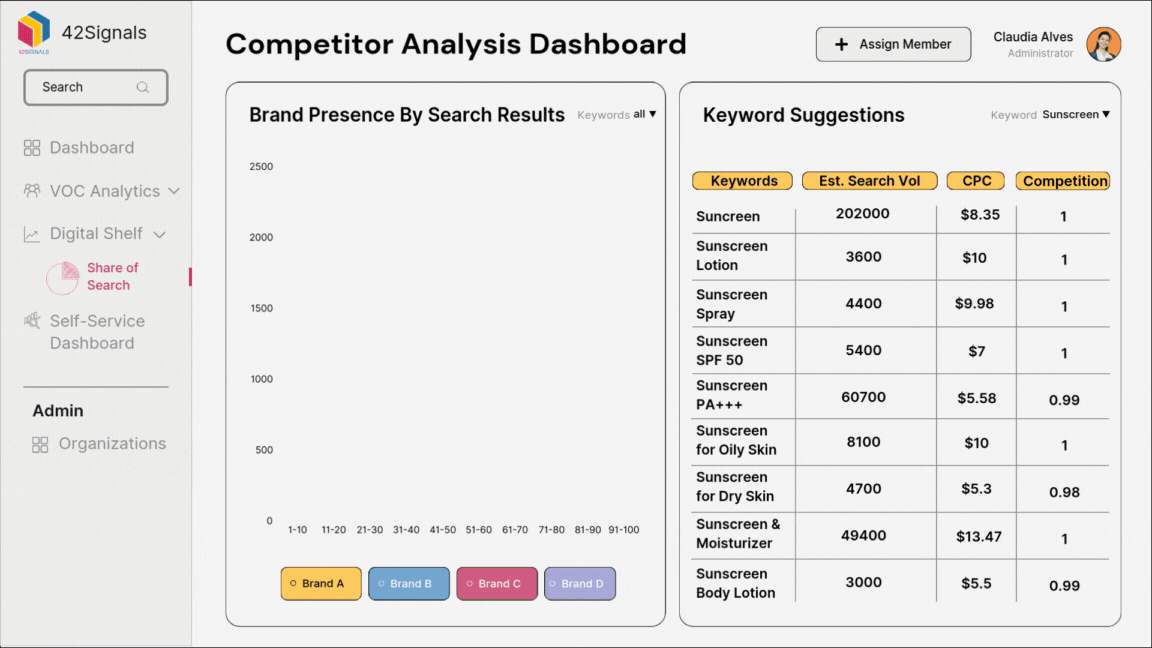
Your competitor analysis dashboard should be a War Room, not a spreadsheet.
2025’s Must-Have Competitor Monitor Features
- Unified Market Share View: See your slice of the pie vs. competitors in real time. This helps keep strategies proactive so quicker changes can be made in real time rather than seeing the advertised effects of competitor dominance over your products.
- Sentiment Heatmaps: Track spikes in negative reviews for rivals (e.g., “defective” mentions = launch a “Reliable Alternative” campaign). This allows for quick resolutions of smaller issues and proper consideration of larger issues that may require further testing and iterations.
- Predictive Battle Cards: AI-generated scripts for sales and marketing teams based on rivals’ weaknesses (e.g., “Competitor X’s shipping is slow—offer free 2-day delivery”). Keeping an ear to the ground on new marketing and promising strategies is a good way to avoid losing out on orders due to bad messaging.
Competitor Monitor Tools to Try
- Crayon 2025: Aggregates data from 50+ sources (even podcasts) to predict competitor R&D moves.
- SEMrush Apollo: Shows competitors’ hidden PPC tactics, like which keywords they’re A/B testing.
Pro Tip
Add a “Nuclear Button” to your dashboard. Example: One click deploys pre-made Amazon Sponsored Ads targeting a rival’s top keywords with a 50% discount promo.
Step 4: Master Digital Shelf Data for Stealth Dominance
Digital shelf data isn’t just about rankings; it’s also about owning every inch of the screen your customers see.
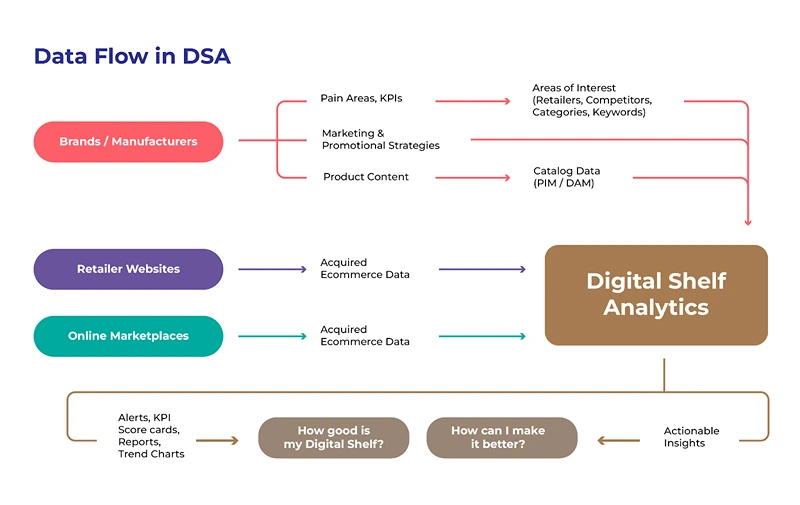
2025 Tactics
- AI-Generated Content: Tools like CopyGenius auto-rewrite product titles using top-performing keywords from competitors. You can also cross-reference this data with other platforms like 42Signals to see what keywords competitors are using and the gap that exists.
- Image Recognition Scans: VisualIQ analyzes rivals’ product images to suggest upgrades (e.g., “Add a size comparison chart—Competitor X’s customers complain about fit”).
- Review Hijacking: Use ReviewBolt to auto-respond to negative reviews on competitors’ pages with your product link. This may not be the ideal way to steal traffic, but it can be effective if you notice certain competitor products consistently getting bad reviews. Diverting them to your product page can give them a better solution to their problems.
Case Study – The Vitamin Brand That Poisoned Its Rival
A supplement company used digital shelf data to find a competitor’s collagen powder had “clumpy texture” complaints. They launched a “Silky Smooth Collagen” line, ran Sponsored Ads on the rival’s product page, and grabbed 18% market share in 60 days.
Step 5: Merge Ecommerce Analytics with Competitor Monitoring Data
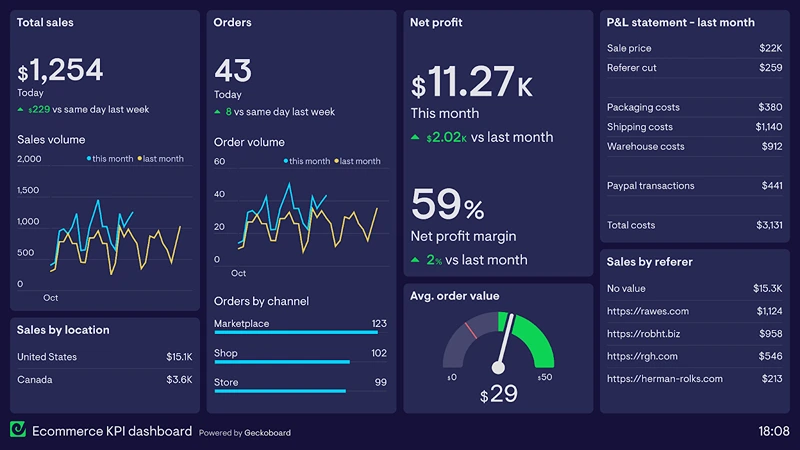
Image Source: Geckoboard
Ecommerce analytics in 2025 means connecting your data with competitors’ to see the full battlefield.
Actionable Integrations
- Cart Abandonment Cross-Analysis: Tools like SaleCycle show if customers abandon your cart to buy a cheaper rival product. Auto-send a discount code. This is crucial as the customer may have decided not to go ahead with the purchase due to a higher order or shipping costs. A discount code could then convince them to purchase as they were already interested in the brand and your products.
- Traffic Source Spying: Use SimilarWeb 2025 to see competitors’ top referral sites. Buy ads there first. A smart way to market and advertise as your brand show up exactly where your competitors are selling.
- Dynamic Bundling: If a competitor’s product is often bought with socks, bundle yours with free socks. You can also curate other bundled items to ensure that complementary items are coupled together. This is very useful when the customer doesn’t realize that they want an item, but seeing the bundle, could understand the benefit of purchasing both products.
Examples of Competitor Monitors
A skincare brand discovered via ecommerce analytics that 30% of their site visitors also checked a rival’s “retinol serum.” They created a “Retinol + Moisturizer” bundle and retargeted those visitors with a 20% off offer, stealing 25% of the rival’s sales.
The Dark Side: Ethical Lines You’ll Want to Cross (But Shouldn’t)
- AI Fake Reviews: Tools exist to generate fake 5-star reviews. Don’t. Amazon’s 2025 AI detects them in 0.2 seconds, and that’s not the road any brand should voluntarily take. Once fake reviews once spotted makes the customer completely mistrustful the brand, and this can lead to a snowball effect.
- Sabotage Bots: Some brands DDOS (Distributed Denial-of-Service where a DDoS attack means that an attacker floods a server with internet traffic to prevent users from accessing connected online services and sites) competitors’ sites during launches. Don’t. (But maybe run a stress test on your own site to prepare.
- Trademark Bidding: Bidding on “Nike Shoes” is allowed, but using their logo in your ad isn’t. This is obvious and something no brand should voluntarily do by infringing on another company’s copyright and trademark.
The Future: AI That Predicts Your Competitors’ 2026 Strategy
2025 is just the warm-up. In the upcoming years, competitor monitoring will become essential. Tools like 42Signals are a great way to competitor monitor and will help brands navigate the quickly developing ecommerce landscape with prompt and actionable insights.
To summarize –
- Brands selling digitally need ecommerce data readily and promptly to stay on top of micro and macro trends
- Manual monitoring is out of the door; ecommerce analytics tools are the future
- Looking at competitor intelligence, quick commerce data, Amazon, and other marketplace intelligence, businesses can make informed decisions on the fly
- Brands that leverage such tools stand to gain and take a large market share
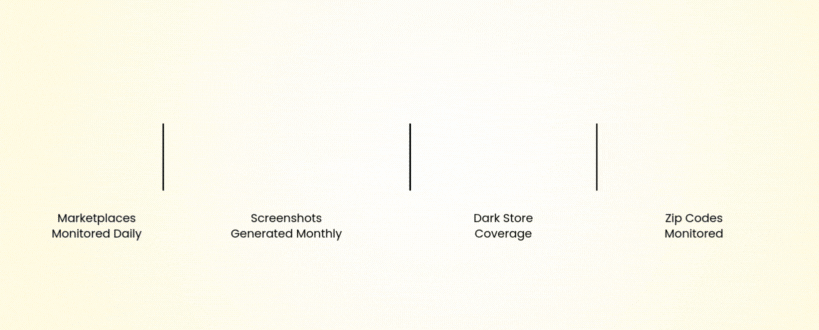
If you’re curious to know more about how this competitor monitor data can help an e-commerce business like yours, schedule a free demo with us, or alternatively, sign up for a free trial to see our easy-to-use platform in action today.
Frequently Asked Questions to Competitor Monitor
What is competitor monitoring?
Competitor monitoring is the ongoing process of observing and analyzing your rivals’ activities in the market. This includes tracking their product launches, pricing changes, marketing campaigns, customer reviews, and distribution strategies.
The goal is to gain insights into their strengths, weaknesses, and market behavior so you can adjust your own strategies to stay competitive, identify market gaps, and anticipate threats or opportunities.
What are the 4 types of competitors?
Competitors typically fall into these four categories:
- Direct Competitors – Businesses that offer the same product or service to the same target market.
Example: Pepsi and Coca-Cola. - Indirect Competitors – Companies that sell different products that solve the same problem or fulfill the same need.
Example: A coffee shop vs. an energy drink brand. - Replacement Competitors – Products or services that could replace yours based on consumer behavior or market trends.
Example: Online learning platforms replacing in-person training. - New/Emerging Competitors – Startups or market entrants that are not well known yet but have the potential to disrupt your space.
Example: A new fintech app entering a traditional banking market.
Understanding each type helps businesses prepare comprehensive competitive strategies.
How to track a competitor?
You can track a competitor using a mix of manual research and automated tools:
- Monitor their website and blogs for updates and announcements.
- Sign up for newsletters to stay informed about new campaigns or product launches.
- Track their social media presence to gauge customer sentiment and engagement.
- Use competitor tracking tools like 42Signals, SEMrush, or SimilarWeb to gather real-time data on pricing, keywords, traffic, and ad spend.
- Analyze reviews on platforms like Amazon, Trustpilot, or Google to see customer feedback.
- Check job postings to learn about their hiring trends and future growth plans.
Combining these methods gives a fuller picture of a competitor’s movements and strategy.
What is a competitor information system?
A competitor information system is a structured platform or framework used by companies to collect, store, analyze, and act on data related to their competitors. It integrates different data sources—such as market research, public filings, digital footprints, and sales intelligence—to support strategic decision-making.
Modern competitor information systems often include:
- Dashboards for performance benchmarking
- Alerts for pricing or promotional changes
- Visualizations of market trends
- Tools for team collaboration and reporting
These systems help businesses stay agile, respond to threats quickly, and maintain a competitive edge.

